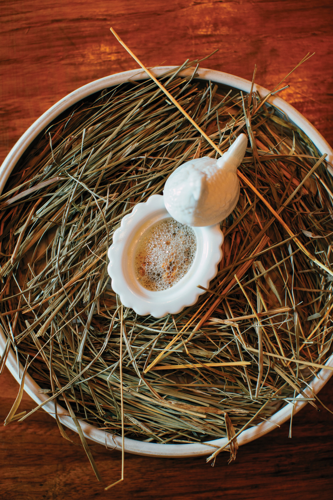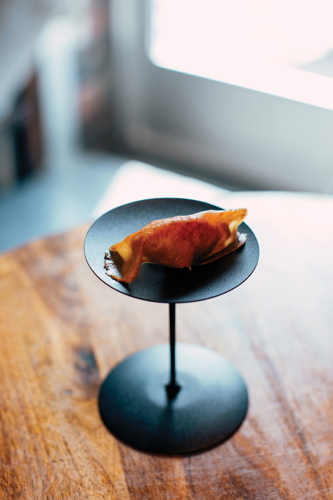
Chef Brian Baxter
Since it opened in 2011, The Catbird Seat has operated in a rarefied space among Nashville restaurants. Designed to be a kind of restaurant lab with frequently changing leadership, Catbird — via its parent company Strategic Hospitality — has for years been stocked with chefs with experience at some of the best restaurants in the world.
It’s also among the hardest to review, for a few reasons: While some other restaurants offer tasting menus, none offer a dozen-plus-course gauntlet spread out over two-plus hours; the techniques on display are meant to challenge as well as delight; and the bar setup around the open kitchen offers a level of interaction with the staff you might find in only one or two other places. At $135 per person, it’s a once-in-a-blue-moon ticket for most diners.
With former Husk and Bastion chef de cuisine Brian Baxter taking the helm earlier this year, the Scene sent writers Ashley Brantley and Steve Cavendish to give the restaurant its first proper consideration in several years.
Steve Cavendish: I’ve had Brian Baxter’s food in some other spots, but this was the first time I’ve eaten a menu entirely by him (and his team). The thing that struck me, as compared to other iterations of The Catbird Seat, is how Southern the point of view was. I mean, at various points there were a tomato finger sandwich (with hackleback caviar) and a straight-up, ain’t-no-sugar-in-the-recipe piece of cornbread in front of us (with, of course, truffle butter).
Ashley Brantley: First of all, God bless Baxter for knowing sugar in cornbread is heresy. Secondly, I agree that the Southern elements were front and center. Looking at the full menu, I feel like it was almost a 30/30/40 split between Southern, classic French and Japanese. For example, that epically satisfying opener you mentioned was on Japanese milk bread with sauce gribiche — so basically French egg-salad sauce — with caviar that comes from the Mississippi River.
Add a sprinkle of Dutch cheese here or a madeira truffle sauce there, but by and large, that Southern/Asian/French split reminded me of the opening Catbird days — kind of reminiscent of early Catbird chefs Josh Habiger and Erik Anderson in its global-but-anchored-here bent.
SC: I think that’s fair. Trevor Moran took Catbird in a more wide-open direction when he was there, while after him Ryan Poli’s mostly European influences were always on display. After that, Will Aghajanian and Liz Johnson spent most of their one-year tenure trying to be deliberately provocative — they told Food & Wine “We’re not making Southern food” — before leaving in a hurry. Baxter feels, in some ways, like a course correction, which is interesting for a place that is designed to be a laboratory of sorts.
But enough comparisons. We landed at the restaurant in the middle of a pandemic, and some things were different. The staff was all masked, and there was significant distance between parties. Part of the vibe of Catbird is that the seats are a wraparound theater for the show being cooked in front of you. I always enjoy watching how the people around me react to the same courses, and the distancing certainly cut down on that shared experience. But that’s a minor gripe (and a temporary one, hopefully, in response to a necessary change). What was your favorite course?
AB: Honestly, I didn’t notice a huge change from the experience perspective. We were still close enough to visually stalk the plates coming out before ours, and to point to drinks and say, “I need that pink wine!” So the experience remained largely intact.
As far as favorites, I narrowed it to three. (And you can’t make me choose, because we aren’t in the same room. Thanks, COVID!) The first is the red pepper three ways — pickled, grilled and escabeche — which was topped with smoked shrimp, burnt-bread sauce and banana pepper emulsion. Not only does it come in a badass bowl that looks like molten lava, but it also stars a bell pepper, which is a vegetable most people treat as an afterthought. The flavor was sweet and subtle but powerfully fresh, which is the kind of magic trick I expect at Catbird. Did that one stick with you?

Mussels
SC: It did, and I’d even put it near the top. But the dish that really got me was the hay-smoked mussels in a sauce poulette with a cured egg yolk. I’m kind of an easy mark for mussel dishes (I once ate them for six straight days on a trip to Belgium; did I mention I have gout?), and this ticked all the boxes — slightly smoky, rich, and it came in a little dish shaped like a hen that became, basically, a shooter when you took the chicken-as-porcelain-top off. It was an amazing bite. It also conformed to the best practices of a great tasting menu, which is to leave you wanting more.
A close second was the Alabama blue crab with summer squash and Japanese curry spice. Again, it was that Southern sensibility stretched in a different direction, which I loved — the curry brought everything together so beautifully, and the fried squash blossom that came with it (also with Japanese flavoring, this time in the form of seven spice) was such a fun complement. What else was on your list?
AB: Mussels, baby! That was also in my top two, for every reason you listed — as well as portion size, which indirectly saved your gout-getting ass from itself. If there was one bite to define the night, that was it.
I liked the crab dish, but at that point in the meal, I wanted a little more punch from the curry or umami from the bonito-cured butter. Salt, fat and crab are my favorite flavors, and this was lovely, but I think it needed to be bumped up in the rotation two spots to be a home run. (Am I using those terms right? My baseball knowledge starts and ends with Sam Malone on Cheers.)
And my final podium pick: I really enjoyed the swordfish sushi — country-ham-ified fish, fried grits done like sushi rice — but it was just edged out for me by the red snapper en papillote. The lemony elements; the non-gooey okra dressed in fermented-green-tomato vin; the sauce made from dry, smoked fish bones. As a nation, we don’t grind enough bones, and Baxter’s doing his part there.
Anything I missed in the savory department?
SC: I liked the swordfish as well, maybe because I loved that fried grit bite so much, but those were the highlights. There were a few misses for me — notably the beef course, which was a piece of ribeye cap cooked in beef fat with a madeira sauce and side of corn purée. It was the least interesting thing we ate in 12 savory courses and four sweet ones. A few stops before, a little bit of raw short rib arrived with tuna, watermelon dashi, cured tomato and little bits of watermelon rind pickled in the style of ginger. It was fascinating to me, even if I preferred other dishes. The ribeye was the last protein course and just felt flat. I think after eating enough tasting menus, I would take almost any vegetable course over another beef-forward one.

Swordfish
AB: I agree. Ultra-rich proteins are ubiquitous, so if you’re going to make one the pinnacle of your tasting menu, it needs to be unforgettable. (See: The sliced smoked duck with morels and garlic scapes we had at Bastion in June, which I’m still drooling over.) I actually thought the side dish — corn fritter wrapped in cured beef belly — was the most interesting part of that beef dish.
Overall, my biggest critique is that I wanted more flavor and fewer ingredients from a few dishes. Take the chanterelles: pain perdu, apricot jam, fermented apricot juice, mushroom jus, midnight moon cheese, chive, tarragon, black butter. That’s what we in the biz call a shit-ton of ingredients. And on paper, they sound like they’d make over-the-top umami magic. But even a day later, my memory of the taste was muddy. I think losing a few elements would actually clarify the flavor. It’s the Coco Chanel school of cooking: Before you leave the house, look in the mirror and take one thing off.
SC: That’s fair. There’s a lot of process in some of these dishes, with a ton of pickling, fermenting and curing, and frequently it pays off. The opening flight of tomatoes — a finger sandwich, a small pie and an ’nduja — showcased a range of preparations pretty brilliantly. Overall, my criticisms are on the margins, because this was a showstopping meal. I’m always intrigued when chefs take over a restaurant, particularly one as successful as Catbird, because there are expectations. At least half of the restaurant’s clientele is from out of state, and that national reputation has been won by an extremely talented set of chefs with large ambitions. Baxter fits into that mold very well.
I don’t want to sidetrack this without getting to dessert, though. We got four courses, and one of them really stood out to me — the doughnut. They took a round ball of pretty light dough, deep-fried it, punctured the bottom and filled it with foie gras bavarian cream, dipped it in a cherry sauce and then smashed freeze-dried cherries and sprinkled the crumbs over the top. It was a near-perfect combination of flavor and texture, and it found that oh-so-satisfying zone of being sweet, but not too sweet, that the best desserts find. It was pure delight, I didn’t even care about the mess I made.

Snapper
AB: I’ll cede the point that there is a ton of successful pickling-adjacent stuff going on behind the scenes; I just wanted one or two of them per dish rather than three or four so I could taste them better.
On the doughnut front, I’ll just agree, full stop. It was another course like the tomatoes where a food memory popped up to anchor it. Bizarrely, this one was eating a cherry danish in Sunday school, but obviously wildly elevated, made with 100 percent more liver and a hell of a lot more finesse. To me, it was a perfect dish, and an example of where Baxter is superb: balancing weird ingredients, technique and nostalgia. That feels very modern-South to me.
SC: So, let me ask you this one question: Where do you put Catbird among Nashville restaurants? In many ways, it’s the ultimate outlier. The price tag means that I’m likely going to eat there once every year or two. The ambition of the place is matched only by a select few restaurants in town. We both get asked this question all the time: Where should I eat in Nashville? Is it a must-go kind of place? I know that buried in that question is the inevitable Should I pay $135 per ticket for a spot at the bar?
AB: Hearing that question, I realize now that I recommend Catbird far more to locals than visitors. I’ll tell friends who live here to save up and go for Their Next Big Thing, but I’m less likely to tell weekend visitors it’s the go-to spot.
I think there are a few reasons for that: 1. There’s more competition in the tasting-course space than ever before with places like Tailor, Setsun East and Bastion, which come in at slightly lower price-points (despite the fact you’re getting more courses and typically more over-the-top WTF-ery per bite at Catbird); 2. It is an experience, and not every visitor to TrashVegas is in the market for that (definitely not all of my hooligan friends); and 3. I think there’s a bit of a local, secret-society element to Catbird that keeps it on a different shelf.
For example, when we were sitting at the counter, we discussed which Catbird chefs we’d gotten to try over the years. I recalled Poli using cookie jars, or Trevor making me eat crab out of its shell with my hands. (I was wearing a silk dress, just sloppin’ around like the dainty Southern belle I am.) But if you go to Alinea in Chicago or Tickets in Barcelona, the meals may change over the years, but it’s not a whole new restaurant. Catbird is. And I think people who care about going to every chef’s version have a kind of SNL-Five-Timers-Club mentality. Is that a little insane? Sure. But it’s also hardcore and fun and pretty fucking cool — just like Nashville’s food scene.

Doughnuts
SC: I keep a recommendations list for out-of-towners in my email, because I get asked once a week for it. You could probably guess half the list. But Catbird isn’t on it, because I don’t think it’s something uniquely Nashville. But I recommend it absolutely to all locals. Why? Because it’s on par with experiences I’ve had in New York, London and Chicago. The ambition of the restaurant has never changed, even though the cast changes every year or two. And even when there are misses — and there absolutely will be on a menu of this size — that desire to delight inevitably outweighs anything that I didn’t love.
AB: Agreed. Is Catbird 5.0 my favorite iteration? Personally, no. But it’s a game of inches, and Baxter’s food is essential eating as far as I’m concerned. Plus he played both “Africa” and “Careless Whisper” on an ’80s playlist while we were there, so the soundtrack is at the top of its game.
SC: I don’t know that I can compare the versions, because it’s wrapped up in memories that probably aren’t the most reliable (and ultimately, as Letterman would say, this is an exhibition, not a competition; please, no wagering). I would say this: It is one of Nashville’s best and most important dining experiences, period, and a required destination meal for anyone in the city who cares about food.






